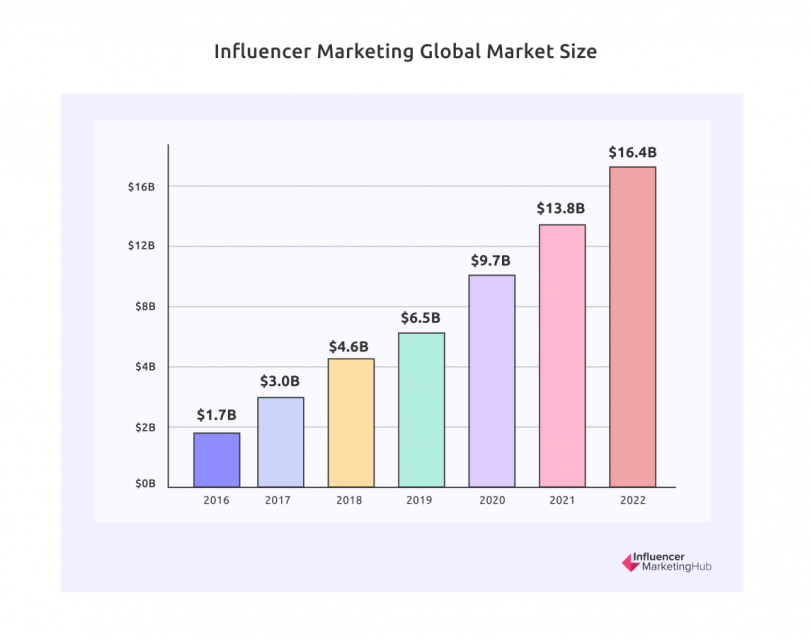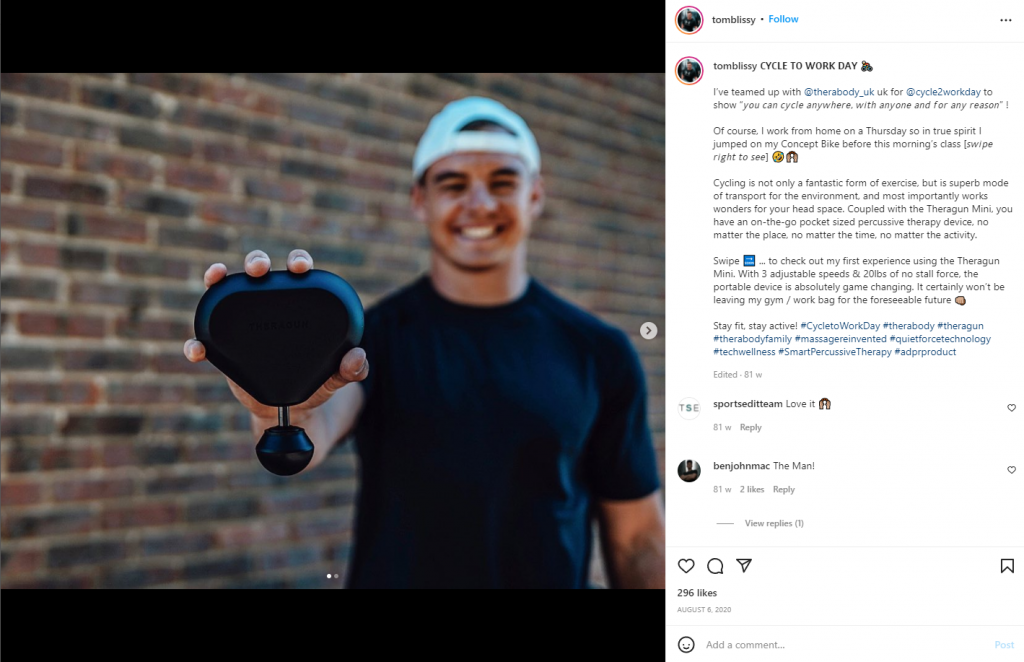The Power of Influencers in Marketing
by Theo Atkinson, Design Enterprise Studio Member, March 2022
Hi, I am Theo, interested in UX and Digital Marketing. Today I am going to share with you my findings about the power of influencer marketing. By the end of this post, anyone who is interested in digital marketing should also have a better understanding of the roles and power of influencers in marketing and why they are becoming increasingly more popular.
I have a keen interest to learn more about this topic because I consume lots of content from influencers/creators myself. Professionally, I am interested in exploring their roles and how they are viewed from a marketing perspective.
Quick Review
From 2016 to the present, influencer marketing has been getting more popular and is very quickly becoming a mainstream form of marketing . I wanted to investigate the reasons of this increase of popularity.
Covid-19 and lockdown has had a major impact globally and changed the way companies have had to market themselves. I started looking into the ways influencer marketing was affected by this and whether or not lockdown was partially responsible for the new popularity of this strategy.
A Global Web Index survey from April 2020 found that 80% of consumers in the U.K and U.S consumed more online video content during Covid. This would suggest that as people consumed more online video content, the use of influencers creating the content to promote a product/ brand became more effective than pre-Covid.
Simon Choi mentions that whilst this was a good opportunity for brands and influencers to engage more deeply with their audiences, it also meant that consumers have applied greater scrutiny, allowing less space for mistakes that could damage a brand. Social restrictions gave opportunities for brands to grow their business, but the stakes were high.
Statistics from the Influencer Marketing Hub show that influencer market size doubled over lockdown, growing from an estimated $6.5 Billion in 2019 to $13 Billion in 2021, and projected to be $16.4 billion by the end of 2022. This shows that lockdown not only accelerated the growth in influencer marketing but also that businesses believe the value of a successful influencer marketing outweighs the potential risks that come with working with influencers.

If influencer marketing is the increasingly preferred approach, how does it actually work?
Building authentic relations with consumers is vital when trying to promote or sell a product. Influencers are people who have built up large audiences through their personalities and the content they create. Followers of these influencers are more likely to trust their opinions and recommendations. This makes them a key tool in building trust for a brand.
Robin Ward suggests that these creators have the potential not just to deepen brand resonance and authenticity, but to become virtual storefronts for retailers. And that this trend will only continue to accelerate as more brand marketers recognise their importance in deepening trust and in building authenticity through credible product recommendations.
Building brand trust with costumers is essential for a profitable business and so influencers appear to be an increasingly effective method of doing so.
Let’s look at an example of how one influencer worked with brands over lockdown:

Tom Bliss is a fitness influencer partnered with Under Armour who posts workout and mobility related content. Over the Covid lockdown he worked with a few brands, for example Grenade, a brand that creates sports performance and active nutrition products such as energy drinks and protein bars, or Therabody, to promote a massage gun product. These partnership deals seem make sense for all parties because Tom uploads related content, and his opinion is trusted by his audience. This in turn would increase the likelihood of his followers purchasing the products as Tom’s promotion appears authentic, not forced.

Whilst partnership deals with influencers seem highly desirable, what might be the most useful approaches to integrate influencers into a marketing strategy to achieve the greatest audience impact?
Reach versus Niche
Clearly, choosing the right influencer for a company’s brand or product is the key to having a successful campaign. So the issue of reach vs niche is something that companies must consider when selecting who to work with. A bigger following isn’t always better and doesn’t equate to a more successful campaign.
Reach or macro-influencers have the advantage of giving greater visibility to a brand or product which could result in more sales. These macro-influencers tend to get high engagement rates on their posts but that comes with the downside of being more costly to work with. As a result, I think that macro-influencers are not always a viable option for every company, despite their reach.
Let’s take a look at a few examples of macro-influencers:
- James Newbury https://www.instagram.com/jamesnewbury/ is a health and fitness influencer with around 237K followers on Instagram.

- Austin Evans https://www.instagram.com/austinnotduncan/ is a tech content creator and influencer with around 508K followers on Instagram and over 5M subscribers on YouTube. https://www.youtube.com/austinevans
- Austin Dunham https://www.instagram.com/austin_dunham/ is another calisthenics based fitness influencer with 349K followers on Instagram and 981K subscribers on YouTube https://www.youtube.com/user/GeekAMD .
On the other hand, niche or micro-influencers tend to have smaller followings and are typically only known within a single community. This is also their main strength because their audiences are very likely to have high engagement and loyalty to the content posted.
Via micro-influencers, companies can access niche audiences and find customers who would be interested in highly specific brands and products. Most importantly, smaller micro-influencers tend to lead to a proportionally higher conversion rate and are generally the more cost-effective option.
Now let’s look at some examples of micro influencers:
- A good example of a micro-influencer would be Tom Bliss https://www.instagram.com/tomblissy/ discussed earlier. He is someone with a moderate following of 35k followers on Instagram.

- Another example would be Adam Gonon, a menswear and lifestyle influencer with 67K followers on Instagram. https://www.instagram.com/adamgonon/
- Jess Larson is another micro-influencer who focuses on cooking healthy recipes with around 46K followers on Instagram. https://www.instagram.com/playswellwithbutter/
How much does it cost to work with influencers?
Bella Foxwell suggests the rule of thumb is around $100 per 10,000 followers for a post. This can of course vary, depending on the size of the influencer or their engagement rate. The Influencer Marketing Hub mentions 8 main factors that can impact the cost:
- The platform they use
- Influencer Reach
- Follower engagement
- Industry or specialisation
- Type of content
- Influencer demand
- Usage rights
- Exclusivity
Another consideration which I think should be made, is related to the authenticity of the influencer that was discussed earlier. This is because as creators become larger, they can often lose the connection with their audience and be viewed as less relatable to their audiences.
Best influencer options for small businesses? Small businesses generally have a smaller budget, so I would recommend working with micro-influencers because they’re more cost-efficient. You could work with multiple micro-influencers for the same price as one macro-influencer. It is likely to obtain better results from this method.
Medium-sized companies should opt to work with a mixture of both micro and macro influencers to get the best of both worlds. This is also suggested by the Influencer Marketing Hub. However, instead of looking for a specific type of influencer, companies should look instead look to find their specific kind of audience.
Looking Ahead
Looking into the role of influencers in marketing has reminded me of how beneficial they already are during campaigns. I also foresee influencer marketing continuing to grow at an even faster rate in the coming years, as more businesses come to realise not only the value influencer campaigns bring to a company but also how to optimise their use.
One scenario for businesses to keep an eye on is influencers creating and promoting their own products. This is already beginning to become a trend, as the partnership of KSI and Logan Paul demonstrates with the release of their successful own brand of drink Prime. Whether the success of influencer-original brands may deter influencers from working with pre-established brands is a topic for another post, but let me know your thoughts.
Hopefully, you have enjoyed reading about influencer marketing and found this post as eye-opening as I have. I am interested to hear your thoughts and opinions on influencer marketing and its future.

Thanks!